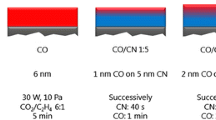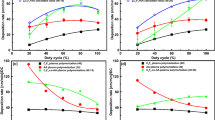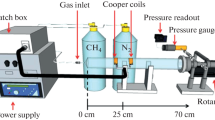Abstract
Oligo(glyme) plasma deposited films (PDFs) are of interest as biomaterials because of their ability to resist protein adsorption and cellular attachment.1 Oligo(glyme) plasma precursors (CH3−O−(CH2CH2O)n−CH3 (n=1−4)) contain the same repeat unit as poly(ethylene glycol) (PEG) and poly(ethylene oxide) (PEO) and are therefore expected to impart a PEG- or PEO-like character to a sample surface.* The minimally-adhesive properties of PEO-modified surfaces have been attributed to “passive” chemical properties such as the absence of sites for receptor binding2, hydrophobic attraction3,4 and ionic interaction. There is evidence that the surface structure is also involved in preventing adsorption—that more “active” steric, osmotic, and entropic repulsive forces arise between mobile, hydrated PEO chains and approaching biomolecules.4,5 But since fragmentation, rearrangement, crosslinking, polymerization, and etching reactions can all occur during plasma deposition6,7, the structure and chemistry of oligo(glyme) PDFs can be expected to differ considerably from that of PEO.
Access this chapter
Tax calculation will be finalised at checkout
Purchases are for personal use only
Preview
Unable to display preview. Download preview PDF.
Similar content being viewed by others
References
G.P. Lopez, B.D. Ratner, C. D. Tidwell, C. L. Haycox, R. J. Rapoza, and T. A. Horbett. Glow discharge plasma deposition of tetraethylene glycol dimethyl ether for fouling-resistant biomaterial surfaces. J. of Biomed Mater. Res. 26: 415 (1991).
E.W. Merrill. Distinctions and correspondences among surfaces contacting blood. Ann. N. Y. Acad Sci. 516: 196 (1987).
G.R. Llanos, and M.V. Sefton. Does polyethylene oxide possess a low thrombogenicity ? J. Biomater. Sci. Polymer Ed, 4: 381 (1993).
S.I. Jeon, J.H. Lee, J.D. Andrade, P.G. De Genres. Protein-surface interactions in the presence of polyethylene oxide. J. of Colloid and Interface Science 142: 149 (1990).
S. Nagaoka, Y. Mori, H. Tanzawa, and S. Nishiumi. Interaction between blood compatible hydrogels containing poly(oxyethylene) chains. Polymers as Biomaterials, S.W. Shalaby, A.S. Hoffman, B.D. Ratner and T.A. Horbett, Eds., Plenum Press, New York, p361–74 (1984).
N. Morosoff. Chapter 1: An introduction to plasma polymerization. Plasma Deposition, Treatment, and Etching of Polymers. R. d’Agostino, Ed., Academic Press, Inc., San Diego, (1990).
H. Yasuda. Plasma Polymerization, Academic Press, Inc., Orlando, FL (1985).
G.P. López and B.D. Ratner. Substrate temperature effects on film chemistry in plasma deposition of organics. I: Nonpolymerizable Precursors, Langmuir 7: 766 (1991).
D. Briggs, A. Brown, J.C. Vickerman. Handbook of Static Secondary Ion Mass Spectrometry (SIMS), J. Wiley & Sons, Chichester, UK, p28–29 (1992).
J.G. Newman, B.A. Carlson, R.S. Michael, J.F. Moulder, and T. A. Hohlt, (Eds.). Static SIMS Handbook of Polymer Analysis, Perkin-Elmer Corp., Eden Prairie, MN, p38–39 (1991).
A. Chilkoti. Surface Chemistry of Organic Plasma Deposited Films Created from Oxygen-containing Precursors, PhD dissertation, University of Washington (1991).
F.W. McLafferty and F. Turecek. Interpretation of Mass Spectra, University Science Books, Mill Valley, CA (1993).
E.E. Johnston and B.D. Ratner. In preparation.
Author information
Authors and Affiliations
Editor information
Editors and Affiliations
Rights and permissions
Copyright information
© 1996 Springer Science+Business Media New York
About this chapter
Cite this chapter
Johnston, E.E., Ratner, B.D. (1996). XPS and SSIMS Characterization of Surfaces Modified by Plasma Deposited Oligo(Glyme) Films. In: Ratner, B.D., Castner, D.G. (eds) Surface Modification of Polymeric Biomaterials. Springer, Boston, MA. https://doi.org/10.1007/978-1-4899-1953-3_5
Download citation
DOI: https://doi.org/10.1007/978-1-4899-1953-3_5
Publisher Name: Springer, Boston, MA
Print ISBN: 978-1-4899-1955-7
Online ISBN: 978-1-4899-1953-3
eBook Packages: Springer Book Archive




